How to Care for Pine Trees During Drought: 2025 Expert Tips

Pine trees grace countless American yards with shade and natural charm. Dry spells test their resilience. Pine tree care during drought involves smart techniques to maintain evergreen health when rainfall dwindles. This includes early stress detection, efficient watering pine trees in drought, and selecting tough varieties. Homeowners grapple with growing water shortages nationwide. Proper pine tree care during drought ensures landscapes flourish despite harsh conditions.
Droughts hit hard in places like the Southwest and Midwest. Trees without sufficient moisture weaken over time. Experts note climate shifts make these periods longer and fiercer. Sustainable practices become vital for yard longevity. People across the USA embrace native plants and efficient habits to reduce waste, supporting sustainable landscaping USA goals. Understanding core methods sets pine owners up for success in pine tree care during drought and overall yard maintenance. Keep in mind that newly planted trees still require careful post-planting care to cope with water stress.
Can pine trees recover from dry soil? Of course, with timely care for pine trees during drought. Care is adjusted depending on changing weather conditions. What are some practical strategies to help ensure full tree growth? Let’s study practical tips for pine tree survival in 2025 in modern conditions. Stay to the end for a downloadable drought checklist—including a 7–10 day Emergency Heat Wave Protocol you can use immediately.
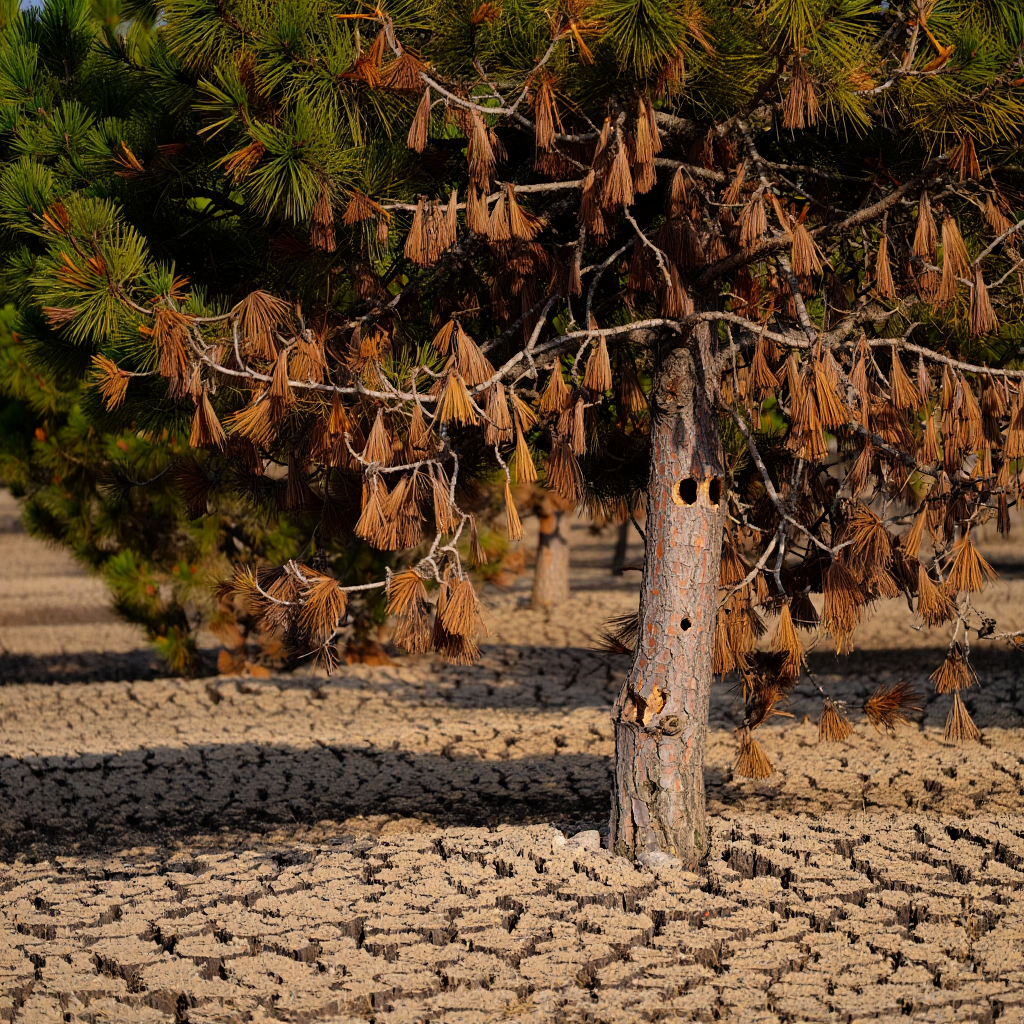
Why Droughts Are Becoming More Common in 2025
Dry periods strike more regions than ever. Climate patterns change due to human impact. Warmer air traps more moisture, causing uneven rain spread. Scientists tie this to rising greenhouse gases.
Climate Change Impacts on U.S. Regions
Higher temperatures dry soil quickly. Studies show droughts grew longer recently. From 2023 to now, widespread events harmed crops and forests.
OECD reports note record-breaking severity in affected areas. About 25% of the lower 48 states faced drought by mid-August 2025. Western regions see sharp rainfall drops. Air pollution further cuts precipitation in spots like the Southwest.
Global warming speeds up evaporation too. This mix turns mild shortages into serious crises. Farmers and gardeners feel the impact first. Urban areas face challenges too.
Why does this affect tree owners? Hotter weather stresses plants faster. Nature’s research shows drought intensity rose 40% globally. In the USA, SPEI data confirm steady declines out West. By late 2024, over 87% of states hit dry or worse conditions. These trends demand adaptive approaches. Ignoring them risks losing precious greenery. Proper pine tree care during drought is critical under these conditions.
Preparing Landscapes for Dry Spells
Assess yard vulnerability first. Choose plants that thrive with less water. Mulch beds to retain moisture. Track weather updates closely.
What happens if rain stays scarce for weeks? Focus on deep irrigation, not frequent sprinkles. Group water-needy plants for efficiency. Native grasses complement conifers well. Avoid over-fertilizing, as it increases hydration needs.
Steps include testing soil initially. Add organic matter if needed. Set up rain barrels for collection. Plant windbreaks to curb evaporation. For detailed guidance on maintaining young trees after planting, see pine tree care after planting. These measures build resilience. Homeowners conserve resources this way, supporting sustainable landscaping USA goals.
Understanding these changes helps protect greenspaces. Proactive steps reduce impacts on cherished evergreens and improve pine tree survival tips 2025.
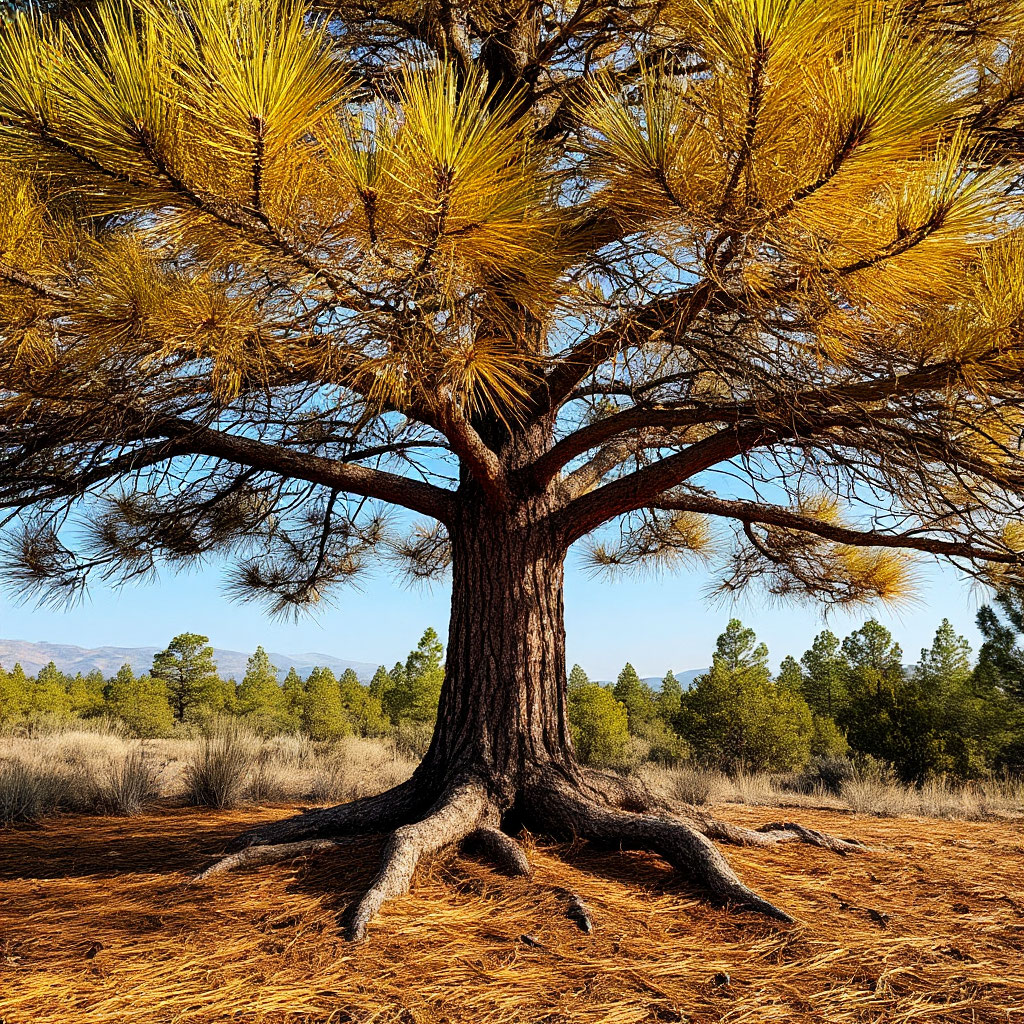
Signs of Stress in Pine Trees During Drought
Pines reveal distress when water lacks. Needles yellow or brown at tips. Branches sag under strain. Bark splits in extreme cases.
Identifying Early Warning Indicators
Check for sparse crowns with faded foliage. Roots may stretch out seeking water. Wilting leaves signal urgent issues. Dropping needles follow if ignored. Curled edges show on younger growth. Small cones indicate ongoing stress. These signs appear before major decline. Regular inspections catch problems early, crucial for pine tree care during drought.
Why do needles discolor? Lack of water disrupts nutrient flow. Photosynthesis slows significantly. Pests target weakened trees. Beetles attack stressed pines. Canker fungi worsen issues after dryness. Trunk scars show poor growth years. Suckers sprout as a last resort.
Monitoring and Response Strategies
Inspect weekly during warm months. Track changes in tree appearance. Trim dead branches carefully. Apply mulch to preserve soil dampness.
How often should inspections occur? Daily in extreme heat. Use probes to check soil depth. Adjust care based on findings. Early action prevents losses. These methods are essential for watering pine trees in drought success.
Tips include setting healthy baselines. Take photos to track progress. Reach out to local extension services. Avoid heavy foot traffic near roots. These practices protect tree health.
Catching issues early enables quick fixes. Healthy pines recover better from tough times. Proper pine tree care during drought is a proven safeguard.
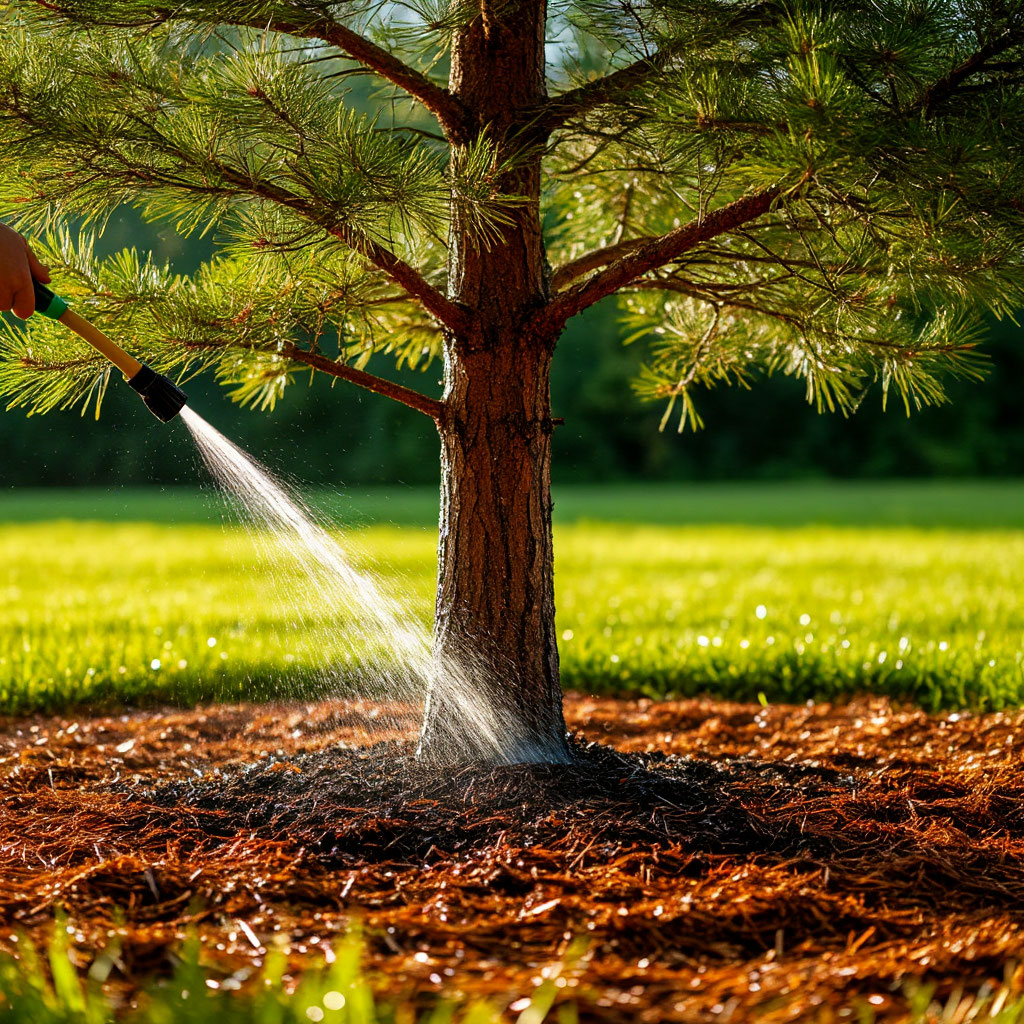
Best Watering Techniques for Drought Conditions
Smart hydration keeps roots strong. Deep soaks outperform shallow sprays. Morning watering cuts evaporation loss. Regular schedules make a difference in watering pine trees in drought routines.
Effective Irrigation Methods
Soaker hoses deliver water slowly. Place them under tree canopies. Run for hours to reach deep layers. Drip systems target roots directly. Avoid overhead sprinklers that lose water. Mature trees need checks every two weeks. Younger ones demand more frequent care.
Why is deep watering better? It builds stronger root networks. Surface moisture vanishes fast. Aim for 1-2 gallons per trunk inch weekly. Test saturation with a screwdriver. Evening watering risks fungal issues.
Step-by-Step Watering Guide
Proper pine tree care during drought is essential for maintaining healthy, vibrant trees during prolonged dry periods. Effective watering is one of the most important steps, as it ensures that roots receive enough moisture to survive and thrive. Following a structured, step-by-step approach allows homeowners to conserve water, prevent stress, and build resilient pine trees even under challenging conditions. The guide below provides detailed instructions for both young saplings and mature pines.
Step 1: Prepare the Area
Before watering, remove any weeds, grass, or debris from around the base of the pine tree. Keeping at least 6–12 inches of clearance around the trunk prevents water from running off and reduces the risk of trunk rot. Lightly loosen the top layer of soil to help water penetrate deeper into the root zone. This preparation ensures that water reaches the roots efficiently and avoids pooling at the surface.
Step 2: Select Your Irrigation Method
Choose an irrigation method that delivers water directly to the roots, such as a soaker hose, drip system, or slow-release watering bag. Avoid overhead sprinklers, as most of the water will evaporate before reaching the soil. Selecting the right method conserves water while keeping your pine tree healthy during drought conditions.
Step 3: Position Your Watering Equipment
Place hoses or drip emitters evenly around the tree’s drip line, which is the outermost edge of the branches. Make sure the emitters cover all sides of the tree to provide uniform moisture. Proper placement helps the roots access water evenly and encourages deeper root growth, which strengthens drought resilience.
Step 4: Determine Watering Depth and Duration
For mature pine trees, aim to water to a depth of 18–24 inches. You can check soil penetration with a soil probe, screwdriver, or metal rod. Run drip systems or soaker hoses for 2–4 hours, adjusting based on soil type and tree size. Sandy soils absorb water quickly, while clay soils require slower application to prevent runoff and ensure proper saturation.
Step 5: Water Young Saplings Differently
Newly planted pines, especially those in their first one or two years, need more frequent watering. Soak the soil daily for 10–15 minutes, making sure moisture reaches 12–18 inches deep. After the first two weeks, gradually reduce watering to once or twice per week, depending on rainfall and temperature. This helps young roots establish and improves long-term pine tree survival tips 2025.
Step 6: Monitor Soil Moisture
After each watering, check that water has reached the root zone. Use a probe or shovel to ensure soil is moist but not soggy. Overwatering can lead to root rot, while dry pockets indicate insufficient irrigation. Consistent monitoring allows for timely adjustments to maintain optimal hydration for your tree.
Step 7: Adjust Based on Weather
Modify your watering schedule according to environmental conditions. During heat waves or prolonged droughts, increase frequency or duration. Conversely, reduce watering after heavy rainfall to avoid oversaturation. Flexible scheduling ensures the tree receives enough water without wasting resources, supporting sustainable landscaping USA practices.
Step 8: Mulch After Watering
Apply a 2–4 inch layer of organic mulch around the tree, keeping it 6–12 inches away from the trunk. Mulch helps retain soil moisture, regulate temperature, and reduce evaporation. It also improves soil structure over time and complements proper watering techniques for pine tree care during drought.
Step 9: Record and Track Watering
Keep a log of your watering routine, soil moisture, and tree health. Taking weekly notes or photos helps track changes and identify early signs of stress. Adjust schedules based on observations, ensuring your irrigation aligns with the tree’s needs and environmental conditions.
Step 10: Repeat Consistently
Consistency is essential for maintaining healthy pines during dry periods. Mature trees typically need deep watering every two weeks, while younger saplings require more frequent care. Following this detailed routine ensures long-term tree vitality, reinforces root systems, and maximizes survival during drought conditions.
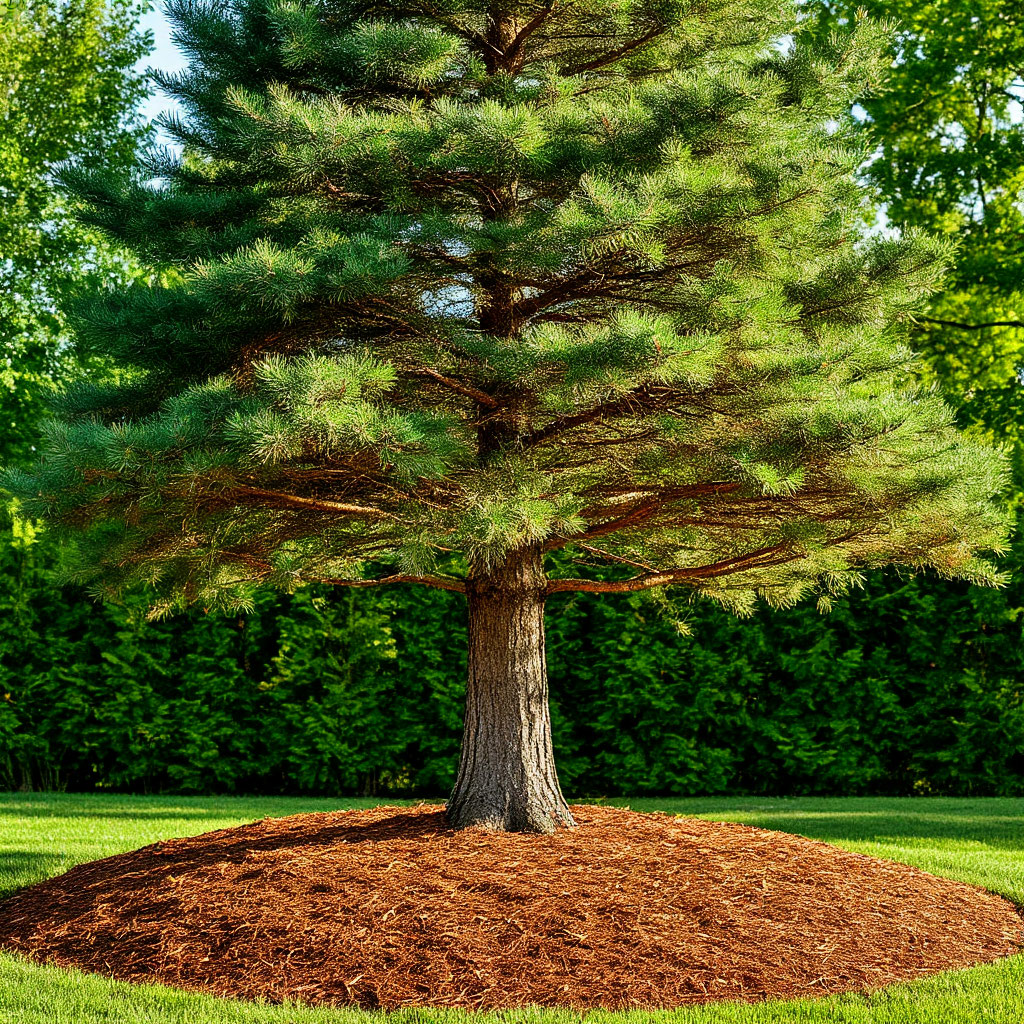
Mulching and Soil Care for Pine Survival
Ground cover boosts moisture retention. Organic layers stabilize temperatures. Healthy soil supports sturdy growth. Amendments enhance structure.
Benefits of Proper Ground Cover
Wood chips block weeds effectively. They decompose to enrich soil. A 2-4 inch layer works best. Extend to drip lines for coverage. This shield reduces evaporation. Cooler roots absorb water better. Mulching complements pine tree care during drought practices.
Why avoid bare ground? Exposed areas dry out fast. Erosion depletes nutrients. Acidic needles suit some pines. Mulch mimics natural forest beds. It nurtures helpful microbes.
Practical Application Instructions
Begin by clearing the area around the base of the pine tree. Remove all weeds, grass, and fallen debris to ensure that mulch can make full contact with the soil. This step reduces competition for water and nutrients and helps prevent fungal growth. Once the area is clean, spread the chosen mulch material evenly around the tree, extending it to the tree’s drip line if possible, while keeping at least 6–12 inches of space directly around the trunk. This gap prevents excess moisture from contacting the trunk, which can lead to rot or pest issues.
After spreading the mulch, water the area thoroughly. Moistening the mulch helps it settle and ensures that water penetrates down to the root zone. A well-watered mulch layer also begins the process of regulating soil temperature, retaining moisture, and promoting microbial activity, all of which are critical for pine tree care during drought and overall tree resilience.
According to Dr. Laura Simmons, a horticulture specialist with over 15 years of experience in drought-resistant landscaping, “Proper mulching is one of the most effective ways to protect pine trees during extended dry periods. A well-applied mulch layer not only conserves moisture but also moderates soil temperature and promotes beneficial microbial activity. Homeowners should focus on organic materials and maintain a consistent depth to maximize tree resilience.” Her recommendations align with best practices for pine tree care during drought, reinforcing the importance of mulching as part of an integrated maintenance strategy.
For pines that prefer acidic soil, such as many native varieties, consider using pine straw whenever possible. Pine straw naturally lowers soil pH and mimics the tree’s native forest floor conditions. Before applying mulch, test the soil pH to determine whether amendments are needed. If the soil is too alkaline, adding compost or other organic material can help balance nutrients and improve structure. When properly applied and kept dry at the edges, mulch rarely attracts pests, but regular monitoring is recommended to catch any issues early.
It is important to refresh the mulch annually as it decomposes. Adding a new layer each year maintains consistent depth, continues to protect the soil from evaporation, and supports healthy root growth. Regular mulch maintenance strengthens resilience during drought, reduces stress on trees, and enhances the performance of drought resistant pine trees by conserving moisture and improving soil quality.
Solid soil care through these methods promotes long-term endurance. Well-maintained mulch layers, combined with proper watering and soil monitoring, create a robust base for pine trees, supporting healthy growth, stronger roots, and better survival rates during dry periods.

Choosing Drought-Resistant Pine Varieties
Tough breeds endure aridity better and require less frequent watering, making them ideal for regions with limited rainfall. Selecting the right variety involves considering local climate conditions, such as average summer temperatures, soil type, and seasonal precipitation patterns.
Native types are particularly well-suited for sustainable landscaping USA goals, as they are naturally adapted to the region’s ecosystem, support local wildlife, and demand fewer chemical inputs like fertilizers or pesticides. Research and local extension service recommendations help homeowners identify varieties that combine drought tolerance, disease resistance, and aesthetic appeal. By choosing resilient types, gardeners can ensure healthier, longer-lived trees and reduce the resources needed for maintenance during dry spells.
Top Recommended Types for 2025
| Variety | Zone Range | Mature Height | Key Features |
| Scots Pine | 3-7 | 30-60 ft | Fast growth, wind resistant |
| Longleaf Pine | 7-10 | 60-100 ft | Fire tolerant, deep roots |
| Ponderosa Pine | 3-7 | 60-100 ft | Aromatic bark, drought hardy |
| Pitch Pine | 4-7 | 40-60 ft | Twisted form, salt tolerant |
| Eastern White Pine | 3-8 | 50-80 ft | Soft needles, quick establishment |
This table aids in picking suitable types for drought resistant pine trees and pine tree survival tips 2025.
Planting and Maintenance Advice
When planting pine trees, selecting the right location and preparing the soil are crucial for long-term health, especially under drought conditions. Choose sites that receive full sun to ensure optimal growth and strong needle development. Before planting, dig holes that are twice as wide as the tree’s root ball to give roots room to expand. Space trees adequately to allow for airflow, reducing the risk of disease. In the first year, apply fertilizer lightly to avoid over-stressing the roots.
Steps for Successful Planting:
- Soak the Roots: Immerse the root ball in water for several hours before planting to hydrate the tree and reduce transplant shock.
- Backfill Carefully: Refill the hole with native soil, gently firming it around the roots to eliminate air pockets while preserving natural soil structure.
- Stake if Necessary: For trees planted in windy areas, use stakes to stabilize the trunk until the root system establishes.
- Prune Lower Limbs Gradually: Remove only damaged or obstructive lower branches during the first year to maintain shape without over-stressing the tree.
Choosing native pine varieties supports sustainable landscaping USA practices and enhances the resilience of drought resistant pine trees. Varieties such as Longleaf Pine adapt well to periods of water shortage, making them excellent choices for low-maintenance, eco-friendly yards.
Wise selection and careful planting simplify ongoing upkeep. Durable pine varieties provide strong, long-lasting growth and make pine tree care during drought more manageable, ensuring vibrant and resilient landscapes for years to come.
FAQ
How do you spot early drought stress in pines?
Early signs of drought stress in pine trees include yellowing or browning of needle tips, wilting or drooping branches, and sparse foliage in the upper crown. Needles may curl at the edges, and small cones may appear prematurely. Roots may stretch outward in search of water, and bark can develop minor splits. Regular inspections, especially during hot, dry months, help catch these signs before serious decline occurs. Addressing these symptoms promptly is an essential step in pine tree care during drought.
Why pick resistant varieties?
Choosing drought-resistant pine trees is vital because these varieties are naturally adapted to survive with less water. They often have deep taproots, needles that retain moisture, and genetic resilience to environmental stress. Resistant types like Longleaf, Scots, and Ponderosa Pines require less intensive care and are less susceptible to pests or fungal diseases during dry spells. Planting these trees supports sustainable landscaping USA practices and improves long-term survival.
What’s better: Drip or soaker hoses?
Drip irrigation and soaker hoses are both highly effective for watering pine trees in drought. Drip systems deliver water directly to the root zone, minimizing evaporation and runoff. Soaker hoses allow slow, deep penetration, which encourages strong root growth. Overhead sprinklers, by contrast, waste water and leave soil surfaces dry while only lightly moistening roots. For optimal results, combine these methods with mulch to retain soil moisture and reduce evaporation.
How often should mulch be applied?
Mulch should be refreshed annually to maintain a 2–4 inch layer around the tree, keeping 6–12 inches clear from the trunk. Mulching helps retain soil moisture, regulate soil temperature, and reduce competition from weeds. It also promotes microbial activity, which improves nutrient availability. Proper mulching complements other pine tree care during drought techniques and helps protect roots during extreme dry periods.
Why are droughts increasing?
Droughts are becoming more frequent due to climate change and rising global temperatures. Warmer air holds more moisture, creating uneven rainfall distribution. Evaporation rates increase, and many regions experience longer, hotter dry periods. In the USA, data shows that western states face extended droughts, impacting not only agriculture but also urban and residential landscapes. Adjusting your pine tree care during drought routine, including watering, mulching, and selecting drought-resistant varieties, is essential to help trees survive these changing conditions. Planning a spring planting? Check current evergreen tree prices to budget correctly.
If you want to see practical techniques for watering trees and shrubs stressed by drought, this video is an excellent guide. It demonstrates effective methods for deep root zone hydration, tips on choosing the right watering time, and techniques to retain soil moisture. Especially useful for pine and other tree owners aiming to maintain health during dry periods.
FAQ
Can I revive a brown pine with pine tree care during drought after it’s already dropped needles?
You might still be able to save it if some needles closer to the trunk are green and flexible. Start with slow, deep watering at the root zone and add organic mulch to keep that moisture from flashing off in the heat. Hold off on major pruning right away, because the tree still needs whatever living tissue it has left to photosynthesize. If all the needles are crispy brown and the branches snap like dry twigs, the tree is most likely past recovery and should be evaluated for removal by a certified arborist.
Is it safe to use gray water for watering pine trees in drought under city watering bans?
Reusing lightly used household water can help keep roots alive when regular irrigation is restricted, but you have to be careful about what’s in it. Mild shower or laundry water without bleach, fabric softener, or heavy detergent is usually safer than kitchen sink water full of grease and salt. Pour it slowly on the soil out near the drip line, not directly on the trunk or needles. If you see a white crust forming on the soil, pause this method because salt buildup can damage roots.
Should I prune branches to save water, or does pruning stress drought resistant pine trees even more?
Heavy pruning during a drought usually does more harm than good. Pines rely on their needles to move water and nutrients, so cutting off a bunch of live growth can actually reduce the tree’s ability to recover. The only trimming most homeowners should do in a dry spell is removing clearly dead or broken limbs that could fall. Big shaping cuts and thinning cuts are better saved for cooler, less stressful weather.
Do I need to fertilize pine trees during extreme heat waves, or should pine tree care during drought skip fertilizer until rain returns?
Skip the fertilizer while the tree is under drought stress. Feeding pushes new growth, and that new growth raises the tree’s water demand at the exact moment water is limited. It’s smarter to focus on stable soil moisture and mulch, which support roots without forcing extra workload. Light feeding can wait until the weather cools and the soil has normal moisture again.
What extra pine tree survival tips 2025 can I use to protect young trees planted near driveways and other hot surfaces in the USA?
Young pines next to concrete or rock get baked from both above and below, so they dry out faster than trees in open lawn. You can set up a temporary shade screen on the west side during heat waves to cut afternoon scorch without blocking all sun. A wide ring of organic mulch (not gravel or rubber mulch) helps insulate roots from radiant heat and slows evaporation. For the first couple of summers, plan on checking soil moisture more often than you would for established drought resistant pine trees in cooler ground.
Conclusion
Caring for pines in dry times requires vigilance and effort. Key steps include monitoring, smart watering, soil protection, and choosing hardy types. These 2025 tips ensure lasting health. Homeowners create resilient yards this way. Start these practices now for vibrant landscapes. Pine tree care during drought ensures survival, while watering pine trees in drought, choosing drought resistant pine trees, following pine tree survival tips 2025, and implementing sustainable landscaping USA techniques keep yards thriving. Before the next heat spike, download the checklist—it turns today’s advice into a step-by-step plan with a 7–10 day emergency routine.
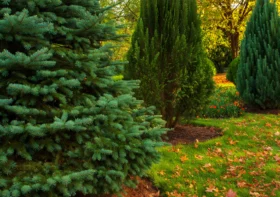


Leave a Reply